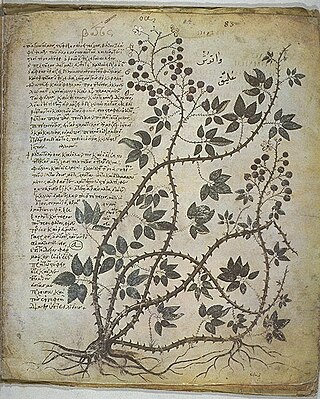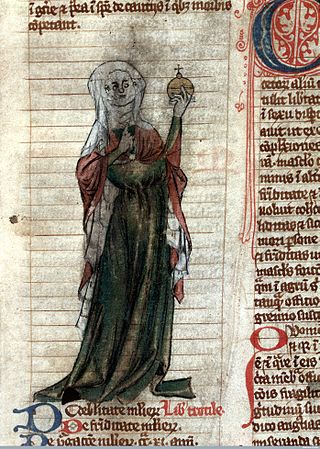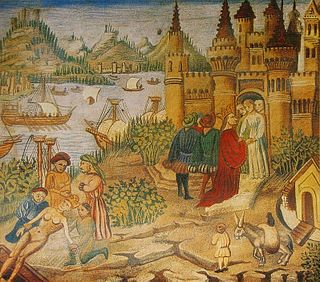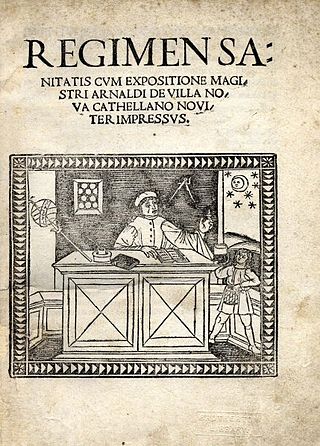Bartholomaeus Anglicus, also known as Bartholomew the Englishman and Berthelet, was an early 13th-century Scholastic of Paris, a member of the Franciscan order. He was the author of the compendium De proprietatibus rerum, dated c.1240, an early forerunner of the encyclopedia and a widely cited book in the Middle Ages. Bartholomew also held senior positions within the church and was appointed Bishop of Łuków in what is now Poland, although he was not consecrated to that position.

Pedanius Dioscorides, "the father of pharmacognosy", was a Greek physician, pharmacologist, botanist, and author of De materia medica —a 5-volume Greek encyclopedia about herbal medicine and related medicinal substances, that was widely read for more than 1,500 years. For almost two millennia Dioscorides was regarded as the most prominent writer on plants and plant drugs.

Materia medica is a Latin term from the history of pharmacy for the body of collected knowledge about the therapeutic properties of any substance used for healing. The term derives from the title of a work by the Ancient Greek physician Pedanius Dioscorides in the 1st century AD, De materia medica, 'On medical material'.

Trotula is a name referring to a group of three texts on women's medicine that were composed in the southern Italian port town of Salerno in the 12th century. The name derives from a historic female figure, Trota of Salerno, a physician and medical writer who was associated with one of the three texts. However, "Trotula" came to be understood as a real person in the Middle Ages and because the so-called Trotula texts circulated widely throughout medieval Europe, from Spain to Poland, and Sicily to Ireland, "Trotula" has historic importance in "her" own right.

A herbal is a book containing the names and descriptions of plants, usually with information on their medicinal, tonic, culinary, toxic, hallucinatory, aromatic, or magical powers, and the legends associated with them. A herbal may also classify the plants it describes, may give recipes for herbal extracts, tinctures, or potions, and sometimes include mineral and animal medicaments in addition to those obtained from plants. Herbals were often illustrated to assist plant identification.

Constantine the African was a physician who lived in the 11th century. The first part of his life was spent in Ifriqiya and the rest in Italy. He first arrived in Italy in the coastal town of Salerno, home of the Schola Medica Salernitana, where his work attracted attention from the local Lombard and Norman rulers. Constantine then became a Benedictine monk, living the last decades of his life at the abbey of Monte Cassino.

The Schola Medica Salernitana was a medieval medical school, the first and most important of its kind. Situated on the Tyrrhenian Sea in the south Italian city of Salerno, it was founded in the 9th century and rose to prominence in the 10th century, becoming the most important source of medical knowledge in Western Europe at the time.

'Ali ibn al-'Abbas al-Majusi, also known as Masoudi, or Latinized as Haly Abbas, was a Persian physician and psychologist from the Islamic Golden Age, most famous for the Kitab al-Maliki or Complete Book of the Medical Art, his textbook on medicine and psychology.

The University of Salerno is a university located in Fisciano and in Baronissi, Italy. Its main campus is located in Fisciano while the Faculty of Medicine is located in Baronissi. It is organized in ten faculties.

Pseudo-Apuleius is the name given in modern scholarship to the author of a 4th-century herbal known as Pseudo-Apuleius Herbarius or Herbarium Apuleii Platonici. The author of the text apparently wished readers to think that it was by Apuleius of Madaura (124–170 CE), the Roman poet and philosopher, but modern scholars do not believe this attribution. Little or nothing else is known of Pseudo-Apuleius apart from this.

Regimen sanitatis Salernitanum, Latin: The Salernitan Rule of Health is a medieval didactic poem in hexameter verse. It is allegedly a work of the Schola Medica Salernitana, a medieval medical school in Salerno. This school founded in the 9th century is considered possibly the oldest medical school, in a southern Italian city, which held the most important medical information, the most famous and notable being Regimen santiatis Salernitanum. Nearly 300 copies of this poem are published, in various languages, for medical professionals.

Latin translations of the 12th century were spurred by a major search by European scholars for new learning unavailable in western Europe at the time; their search led them to areas of southern Europe, particularly in central Spain and Sicily, which recently had come under Christian rule following their reconquest in the late 11th century. These areas had been under Muslim rule for a considerable time, and still had substantial Arabic-speaking populations to support their search. The combination of this accumulated knowledge and the substantial numbers of Arabic-speaking scholars there made these areas intellectually attractive, as well as culturally and politically accessible to Latin scholars. A typical story is that of Gerard of Cremona, who is said to have made his way to Toledo, well after its reconquest by Christians in 1085, because he
arrived at a knowledge of each part of [philosophy] according to the study of the Latins, nevertheless, because of his love for the Almagest, which he did not find at all amongst the Latins, he made his way to Toledo, where seeing an abundance of books in Arabic on every subject, and pitying the poverty he had experienced among the Latins concerning these subjects, out of his desire to translate he thoroughly learnt the Arabic language....

Theodoric Borgognoni, also known as Teodorico de' Borgognoni, and Theodoric of Lucca, was an Italian who became one of the most significant surgeons of the medieval period. A Dominican friar and Bishop of Cervia, Borgognoni is considered responsible for introducing and promoting important medical advances including basic antiseptic practice in surgery and the use of anaesthetics.
Gilles de Corbeil was a French royal physician, teacher, and poet. He was born in approximately 1140 in Corbeil and died in the first quarter of the 13th century. He is the author of four medical poems and a scathing anti-clerical satire, all in Latin dactylic hexameters.

The history of pharmacy as a modern and independent science dates back to the first third of the 19th century. Before then, pharmacy evolved from antiquity as part of medicine. The history of pharmacy coincides well with the history of medicine, but it's important that there is a distinction between the two topics. Pharmaceuticals is one of the most-researched fields in the academic industry, but the history surrounding that particular topic is sparse compared to the impact its made world-wide. Before the advent of pharmacists, there existed apothecaries that worked alongside priests and physicians in regard to patient care.
Bartholomaeus of Bruges was a Flemish physician and natural philosopher.

Taddeo Alderotti, born in Florence between 1206 and 1215, died in 1295, was an Italian doctor and professor of medicine at the University of Bologna, who made important contributions to the renaissance of learned medicine in Europe during the High Middle Ages. He was among the first to organize a medical lecture at the university.

Trota of Salerno was a medical practitioner and writer in the southern Italian coastal town of Salerno who lived in the early or middle decades of the 12th century. Her fame spread as far as France and England in the 12th and 13th centuries. A Latin text that gathered some of her therapies was incorporated into an ensemble of treatises on women's medicine that came to be known as the Trotula, "the little book [called] 'Trotula'". Gradually, readers became unaware that this was the work of three different authors. They were also unconscious of name of the historical writer, which was "Trota" and not "Trotula". The latter was thenceforth misunderstood as the author of the whole compendium. These misconceptions about the author of Trotula contributed to the erasure or modification of her name, gender, level of education, medical knowledge, or the time period in which the texts were written; this trend often resulted from the biases of later scholars. Trota's authentic work was forgotten until it was rediscovered in the late 20th century.
Adelle of the Saracens was an Italian physician. She belonged to the Saracinensa family and was a lay teacher at the medical faculty of Salerno. Her medical practice stemmed from roots in the Salerno Medical School and she practiced Medieval and Early Italian Renaissance Ideals in her medicine including Humanism.

The women of Salerno, also referred to as the ladies of Salerno and the Salernitan women, are a group of women physicians who studied in medieval Italy, at the Schola Medica Salernitana, one of the first medical schools to allow women.